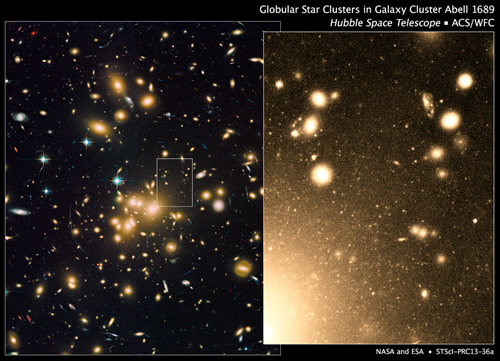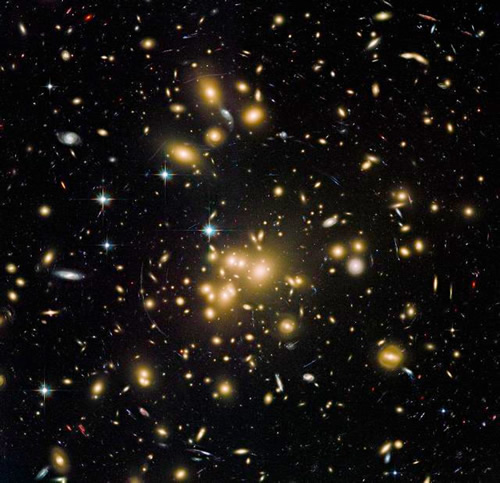
Images of the fascinating galaxy cluster Abell 1689 would nearly as revealing if it weren't for the phenomenon known as gravitational lensing. But what is gravitational lensing? And what do the latest images reveal about the incredible galaxy cluster Abell 1689? Read on to find out!
Although our backyard telescopes will never reveal huge galaxy cluster Abell 1689 the way the Hubble Space Telescope does, even the Hubble gets an occasional "hand" with its vision. In the case of this spectacular Galaxy Cluster, it's a phenomenon known as gravitational lensing - an affect which magnifies the light beyond it. Like a gigantic zoom eyepiece in space, Abell 1689's huge amount of gravity warps and convolutes the space surrounding it, allowing astronomers to take an even closer look at distant objects. What appear to be smears and streaks of light are actually even more galaxies!

As you examine the image, you'll see intense stars, wads of star-stuff which look like golden cotton candy and distant, mysterious spiral galaxies. Here, you will witness huge, magnificent galaxies being ripped apart, their material pulled into space. The detritus leaves thin, blue trails which curve around the galaxies in the middle. This is where new suns are being formed at a break-neck speed. The hot, young, blue stars are imparting both their emissions - and colors - to the galactic pallet.
However, the distant galaxies are only a bonus to this Hubble observation. Abell 1689 is under study for its huge population of globular clusters. While the space telescope first examined this cluster 11 years ago, this new image includes infrared data from Hubble's Advanced Camera for Surveys (ACS). With a total imaging time of over 34 hours, the new data set unveils structure in greater detail than ever before. It verifies that Abell 1689 contains the largest population of globular clusters found so far... some 10,000 of them. By comparison, the Milky Way only contains about 150 of these ancient collections of stars, and researchers estimate the galaxy cluster could be home to as many as 160,000 in total.
As for gravitational lensing, this isn't the first time astronomers have used this trick for surveying ever deeper into this particular galactic neighborhood. Just three years ago, they used the technique to study the elusive phenomena of dark matter and dark energy by mapping the composition of Abell 1689. It also revealed the presence of the brightest and youngest galaxy so far discovered - A1689-zD1 - only five years ago.
Gravitational lensing is such a powerful tool that it will play a crucial role during Hubble's upcoming Frontier Fields program, as mankind peers even further into the distant Universe.
And just where will the Frontier Fields take us? According to the goals, "After considering valuable advice from the astronomical community and broad range of open questions in galaxy evolution, the committee has unanimously recommended a program of six deep fields centered on strong lensing galaxy clusters in parallel with six deep blank fields."

Hubble Image of Abell 1689
It will further our understanding of stellar mass and formation during our Universe's earliest times, shedding light on how the very first galaxies evolved. In addition, it will look at galaxies that are 10 - 50 times fainter intrinsically than any presently known and hopefully pick out enough internal structure to even be studied spectroscopically.
For now, enjoy this incredible image and remember the words of Walt Whitman: "I open the scuttle at night and see the far-sprinkled systems, And all I see multiplied as high as I can cypher edge but the rim of the farther systems. Wider and wider they spread, expanding, always expanding, Outward and outward and forever outward."
Image Credit: NASA, ESA, the Hubble Heritage Team (STScI/AURA), J. Blakeslee (NRC Herzberg Astrophysics Program, Dominion Astrophysical Observatory), and H. Ford (JHU)
About Tammy Plotner - Tammy is a professional astronomy author, President Emeritus of Warren Rupp Observatory and retired Astronomical League Executive Secretary. She's received a vast number of astronomy achievement and observing awards, including the Great Lakes Astronomy Achievement Award, RG Wright Service Award and the first woman astronomer to achieve Comet Hunter's Gold Status.















